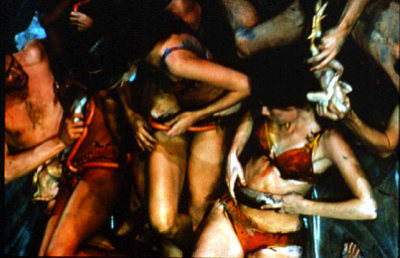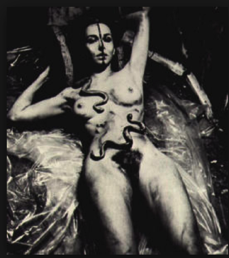The Feminist Body Contingent
April 2014. Published at the SVA Website.
This text is based on the lecture Leaving a Mark—Painting Body/Gestural Body—Feminist Subjectivities, by the art historian Jovana Stokic (AP Faculty), the essay Body Art: Performing the Subject by Amelia Jones, and the work of artists Carolee Schneemann and Yayoi Kusama. I use these feminist historians and artists as examples because they reject conventional patriarchal artistic models organized around male artists and male subjectivity, as well as notions of art rooted in the object alone. Crucial to my argument is that performance of the 60s and 70s in particular, challenged the dominant patriarchal art historical tradition, pushing the boundaries of art towards the interconnectivity.
THE BODY TOWARDS SUBJECTIVITY
In her essay leaving a Mark, Jovana Stokic states, “Body art does not strive toward a utopian redemption but, rather, places the body/self within the realm of the aesthetic as a political domain.” According to Stokic, parafeminists[1] redefined the normative view of the artist, which had until then been predominantly white, male and upper-middle-class. By invoking the gender, sexuality and ethnicity [in the case of Kusama] the notion of the “self” is dislocated and what had previously been typed as the marginalized body shifts into the center.
The body and its parts, specially the eye, are an active medium of perception and production of energy. The fundamental life of any material I use is concretized in that material’s gesture: gesticulation, gestation—source of compression…resistance…
Carolee Schneemann
From the Notebooks (1962-63), quoted above, Schneemann affirms that this new body becomes a visual site. It imprints itself in space. Eye Body-36 transformative actions allowed the artist to merge and to unify her body with the materials. “ I am both image maker and image. The body may remain erotic, sexual, desired, desiring, but it is as well votive: marked, written over in a text of stroke and gesture discovered by my creative female will,” she says.
Many early theoretical writers on parafeminism such as Mary Kelly were still too influenced by the modernist patriarchal tradition. Jones claims that these early writings failed to understand the radical potential of the body as medium and performance’s approach to intersubjectivity by condemning them as narcissistic and reactionary—merely collections of self-referential gestures. In Schneemann’s work the body was not self-centered nor idealized by male-oriented views of the Cartesian model. It was a tool for participation, unveiling the artist and the “self” within cultural and social contexts. It became subject and object in direct discourse with the viewer.
The female subject is not simply a “picture” in Schneemann’s scenario but deeply constituted (and never fully coherent) subjectivity in the phenomenological sense, dialectically articulated in relation to others in a continually negotiated exchange of desires and identifications.[2]
Yayoi Kusama
In 1962, Yayoi Kusama enacted a pinup girl lying on “her vertiginous landscape of phallic knobs,” (Stokic) and “acted her own double otherness – racially and sexually different from the conception of euro American male artist” (Stokic). We must remember that America was going through the sexual revolution, the anti-war movements, free love, the drug culture and the emergence of multinational capitalism. Apollo 11 was about to land on the moon. Neil Armstrong would soon step onto its surface and be watched by 500 million people worldwide by video transmission. There was nuclear testing going on. The U.S. placed an embargo against Cuba leading to Cuban Missile Crisis of October 1962. Marilyn Monroe was found dead from an overdose of sleeping pills, and chloral hydrate (rumored to be a Kennedy “hit.”). Within this context performance art became one the most dynamic modes of dealing with subjectivity.
MAKING CONTINGENCY
Contingency refers to a future event that is possible, but cannot be predicted with certainty, that is dependent on chance or on the realization of a condition. In the essay Three Figures of Contingency, by Robin Mackay, contingency can only be grasped as an event. By privileging contingency, instead of chance, one challenges systems of thought that subordinate events to a predestined outcome or prediction. Mackay claims “we are all products of contingent events, webs and networks of anonymous forces. “
Female performance artists such as Schneemann and Kasuma approached the investigation of desire and thematized feminine beauty in order to radically criticize the Western male-oriented fixed model of representation of female bodies as fetishes and commodities. In body art and performance, the emphasis on chance brings the viewer into the work as an event as interpretative exchange “through the reversibility of seeing and being seen, perceiving and being perceived,” suggests Amelia Jones. Those performances were about engagement and mutual construction of meanings between the artist and the viewer, intersubjective, which means, one contingent on the other and upon the world.
These artists were not afraid of the ephemeral, the precarious, and the transitory. They were aware that art was walking upon the finest threat of repression and eradication of human complexity. To inquire is to be alive. In doing it so, they celebrated their bodies and their practices as inevitable happenings.
FOOTNOTES
This piece was developed as a performative reading between JaeWook Lee and me. We both chose each other’s writing and re-worked collaboratively in this textual production.
[1] “The fraught relationship between some women artists and feminism can be resolved by employing the critical notion of parafeminism. This conceptual model of critique and exploration is simultaneously parallel to and building on (in the sense of rethinking and pushing the boundaries of, but nor superseding) earlier feminisms.” Leaving a Mark—Painting Body/Gestural Body—Feminist Subjectivities, by Jovana Stokic
[2] Amelia Jones, Body Art: Performing the Subject (Minneapolis and London: University of Minnesota Press, 1998), pp
Carolee Schneemann | Eye Body: 36 Transformative Actions |1963
Carolee Schneemann | Meat Joy | 1964

